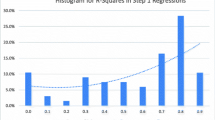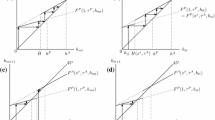Abstract
One of the major concerns associated with school voucher proposals is that they will only benefit those who leave public schools in favor of private schools. The children left behind in public schools are expected to necessarily be made worse off by such policies. This paper provides evidence suggesting that children left behind in public schools will also benefit. The available evidence suggests that, after a voucher plan, voter support for public schools will rise enough to increase the human capital of public school students, despite the presence of negative peer group effects.
Similar content being viewed by others
References
Card, D. and Krueger, A. (1992). Does school quality matter? Returns to education and the characteristics of public schools in the United States.Journal of Political Economy 100 (1): 1–40.
Chubb, J. and Moe, T. (1990).Politics, markets, and American schools. Washington: Brookings Institution.
Coleman, J.S. and Hoffer, T. (1987).Public and private high schools. New York: Basic Books.
Finn, J. and Achilles, C. (1990). Answers and questions about class size: A statewide experiment.American Educational Research Journal 27 (Fall): 557–577.
Flowers, M.R. (1988). Tuition tax credits and the public schools.National Tax Journal 41: 87–96.
Frey, D. (1983).Tuition tax credits for private education. Ames: Iowa State University Press.
Frey, D. (1991). Demand and supply elasticities for private education: A rejoinder.Public Finance Quarterly 19 (July): 369–376.
Friedman, M. (1962).Capitalism and freedom. Chicago: The University of Chicago Press.
Greenwood, D. (1983). An estimation of U.S. family wealth and its distribution from microdata, 1973.Review of Income and Wealth, Series 29, No. 1 (March): 23–44.
Hanushek, E.A. (1986). The economics of schooling.Journal of Economic Literature 24 (September): 1141–1177.
Inman, R.P. (1978). Testing political economy's “as if” proposition: Is the median voter really decisive?Public Choice 33: 45–65.
Ireland, N. (1990). The mix of social and private provision of goods and services.Journal of Public Economics 43 (November): 201–220.
Kroch, E. and Sjoblom, K. (1986). Education and the national wealth of the United States.Review of Income and Wealth, Series 32, No. 1 (March): 87–106.
Lankford, H. and Wyckoff, J. (1992). Primary and secondary school choice among public and religious alternatives.Economics of Education Review 11: 317–338.
Levin, H.M. (1992). The economics of educational choice.Economics of Education Review 10 (2): 137–158.
Lieberman, M. (1989).Privatization and educational choice. New York: St. Martin's Press.
Lott, J.R. (1987). Why is education publicly provided? A critical survey.Cato Journal 72 (Fall): 475–501.
Martinello, F. and West, E.G. (1991). Education budget reductions via tax credits: Some further considerations.Public Finance Quarterly 19 (July): 355–368.
Meyer, R.H. and Wise, D.A. (1982). High school preparation and early labor force experience. In R.B. Freemand and D. Wise,The youth labor market problem: Its nature, causes, and consequences. Chicago: The University of Chicago Press.
Murnane, R.J. (1986). Comparisons of private and public schools: The critical role of regulations. In D.C. Levy (Ed.),Private education: Studies in choice and public policy. Oxford: Oxford University Press.
National Center for Education Statistics. (1991).Private schools in the United States: A statistical profile, with comparisons to public schools. Washington: U.S. Department of Education.
Nye, B., Zaharias, J.B., DeWayne Fulton, B., Achilles, C.M. and Hooper, R. (1991). The lasting benefits study. Tennessee: Center of Excellence for Research in Basic Skills.
Rangazas, P. (1991). Vouchers in a dynamic model of a “poor” community. Working Paper.
Rangazas, P. (1992a). On assessing voucher plans: With special attention to peer group effects. Working Paper.
Rangazas, P. (1992b). Teacher unions, competition, and school vouchers. Working Paper.
Rangazas, P. (1992c). Vouchers in a community choice model with zoning. Working Paper.
Romer, T., Rosenthal, H. and Munley, V. (1992). Economic incentives and political institutions: Spending and voting in school budget referenda.Journal of Public Economics 49: 1–33.
Schmidt, A.B. (1992). Private school enrollment in metropolitan areas.Public Finance Quarterly 20 (July): 298–320.
Sonstelie, J. (1982). The welfare cost of free public schools.Journal of Political Economy 90 (4) (August): 794–808.
Summers, A.A. and Wolfe, B.L. (1977). Do schools make a difference?American Economic Review 67 (September): 639–652.
Word, E.J., Pate Bain, H., Dewayne Fulton, B., Zaharias, J.B., Achilles, C., Lintz, M.N., Folger, J. and Breda, C. (1991). Students/Teacher Achievement Ratio (STAR): Tennessee's K-3 class size study. Final Summary Report, 1985–1990, Nashville, TN: Tennessee State Department of Education.
Witte, J.F. (1992). Private school versus public school achievement: Are there findings that should affect the educational choice debate.Economics of Education Review 11: 371–394.
Author information
Authors and Affiliations
Additional information
This paper has benefited from the comments of Ed Buffie, James Heckman, Tom Philipson, Bob Sandy, and the participants at the IUPUI seminar, the Microeconomics Workshop at Indiana University, and the Public Policy Workshop at the University of Chicago. I would also like to thank Sharon Zehr Rangazas for her assistance.
Rights and permissions
About this article
Cite this article
Rangazas, P. Vouchers and voting: An initial estimate based on the median voter model. Public Choice 82, 261–279 (1995). https://doi.org/10.1007/BF01047697
Accepted:
Issue Date:
DOI: https://doi.org/10.1007/BF01047697




